
Parathyroidectomy is indicated for primary hyperparathyroidism and for secondary hyperparathyroidism refractory to medical treatment (Figures 1, 2).


A detailed knowledge of parathyroid anatomy is essential to perform parathyroidectomy safely and effectively. Particular attention needs to be paid to
identifying ectopic or unusually located glands and to avoid injury to important local structures, particularly the recurrent laryngeal nerve (RLN).
There are typically four parathyroid glands; supernumerary glands and <4 glands do occur. The parathyroids are generally located symmetrically in the neck in close proximity to the thyroid gland (Figure 3).
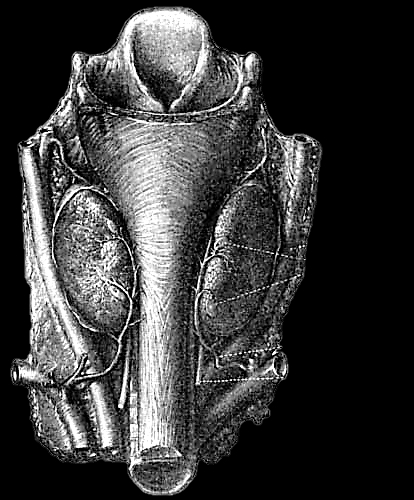
Their characteristic golden-tan colour varies from yellow to reddish brown. Their colour permits for them to be distinguished from the pale-yellow lymph nodes, thymus, mediastinal fat, and the dark-red thyroid parenchyma. They have a diameter of about 3-8 mm and are usually oval-shaped, but may also be tear-shaped, drop-like, spherical, elongated, rod-like or flattened.
The superior parathyroid glands originate from the 4th pharyngeal pouch and adhere to the posterior surface of the caudally migrating thyroid. They have a much shorter distance to migrate than the inferior parathyroid glands; this would account for their more predictable location. They are embryologically and anatomically closely related to the Tubercle of Zuckerkandl, and are usually found posteriorly at the level of the upper two-thirds of the thyroid about 1cm above the crossing point of the RLN and inferior thyroid artery (ITA) (Figure 4).
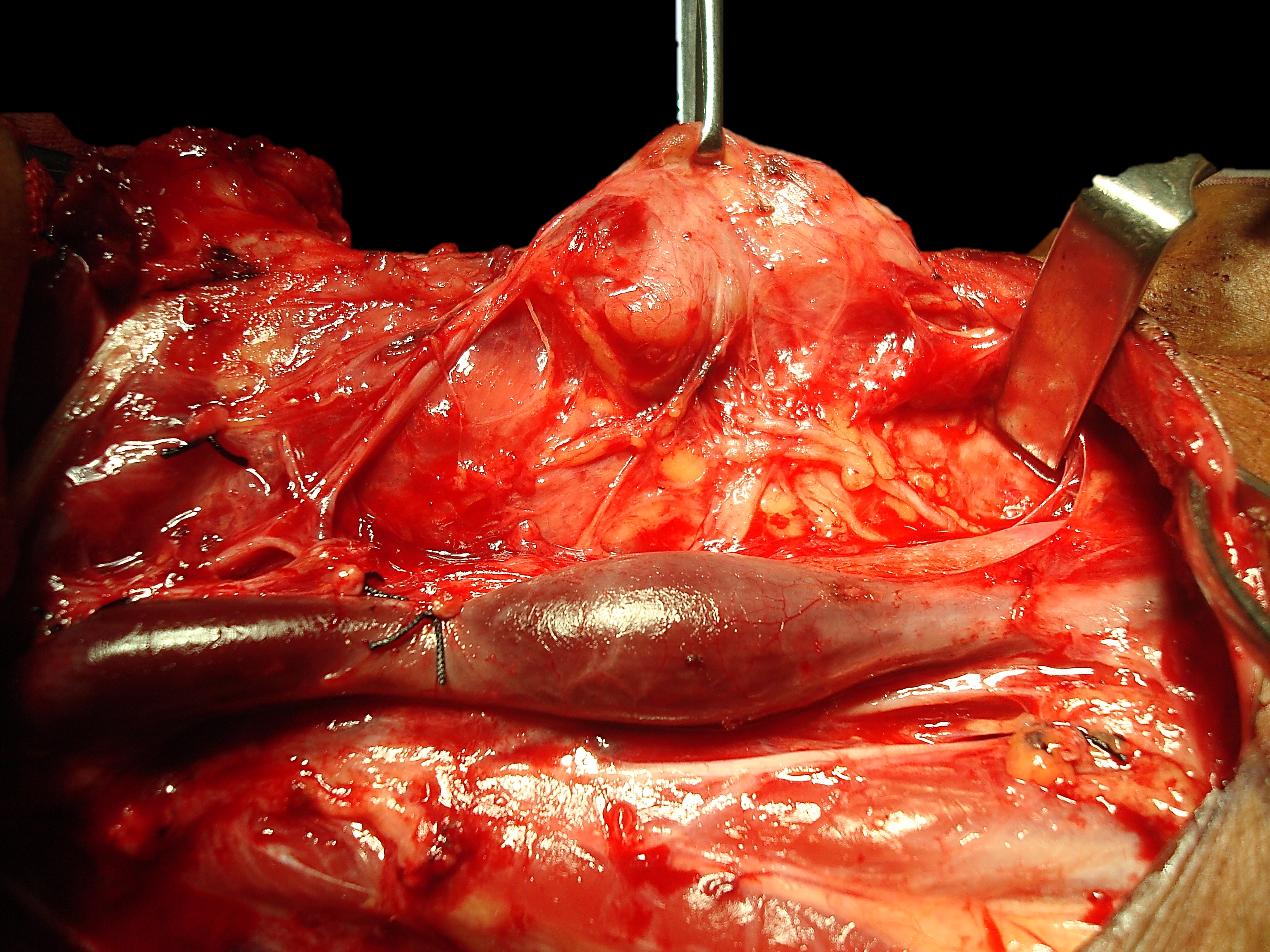
Ectopic superior parathyroids are uncommon (1%) and may be found in the posterior neck, retropharyngeal and retroesophageal spaces and intrathyroidally (Figure 5).

The inferior parathyroid glands arise from the dorsal wings of the 3rd pharyngeal pouches. They join the thymus as it migrates caudally and medially to its final position in the mediastinum. Ectopic inferior parathyroid glands can be found anywhere along this large area of descent from the proximal neck down to the superior border of the pericardium. Their commonest location is on the anterior or the posterolateral surfaces of the lower pole of the thyroid, between the lower pole of thyroid and thyroid isthmus (42%, Wang et al); or within the thyrothymic ligament in the lower neck in proximity to the thymus (39%). Other locations include lateral to the thyroid, within the carotid sheath (15%), or within mediastinal thymic tissue and pericardium (2%). (Figure 5)
The inferior parathyroids are usually found in a plane more ventral to that of the superior glands. If the RLN’s course is viewed in a coronal plane, then the superior parathyroid glands are located deep (dorsal) and the inferior parathyroid superficial (ventral) to the plane of the nerve (Figures 6, 7).
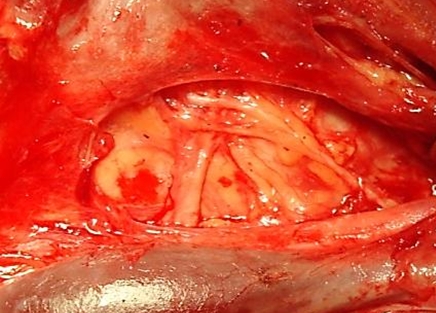

The inferior thyroid artery (ITA) is a branch of the thyrocervical trunk, which in turn arises from the subclavian artery (Figures 3, 5). It is the predominant vascular supply to both the upper and lower parathyroids (Figures 3, 8). Consequently division of the main trunk of the ITA during thyroidectomy is discouraged as it places both parathyroids at risk of ischaemic injury.
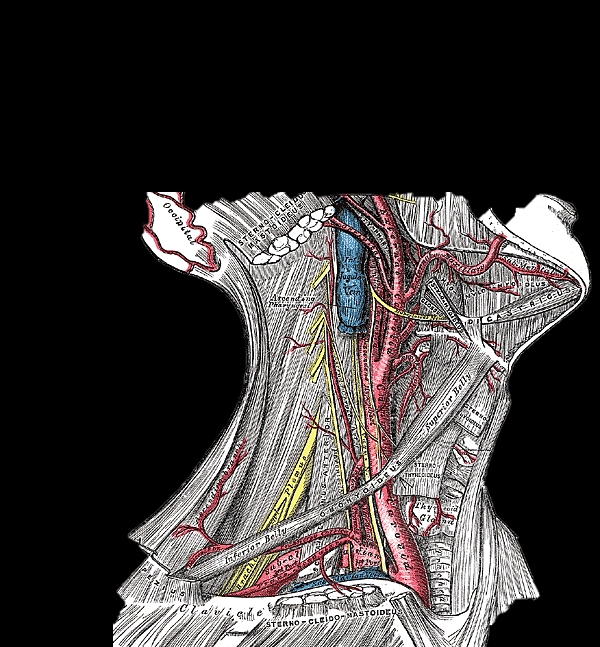
The ITA courses superiorly along the surface of the anterior scalene muscle before turning medially behind the carotid sheath from where it reaches the inferior pole of the thyroid gland. It provides blood supply to the parathyroids, thyroid, upper oesophagus and trachea. Its branches communicate with the superior thyroid artery (STA) and with the blood supply of the contralateral thyroid lobe via the thyroid isthmus.
The Recurrent Laryngeal Nerve (RLN) is a key structure in any exploration of the central neck. Identification and preservation of the RLN during thyroid and parathyroid surgery is essential to minimise morbidity. The RLN innervates all the intrinsic muscles of the larynx except the cricothyroid muscle (SLN) and provides sensory innervation to the larynx. Even minor neuropraxia may cause dysphonia; irreversible injury confers permanent hoarseness. The incidence of RLN injury during thyroidectomy is 0-28% and is the most common reason for medicolegal claims following thyroidectomy; the incidence of injury during parathyroidectomy is much lower.
The RLNs originate from the Xn. After circling around the subclavian artery (right) and aortic arch (left) the RLNs course superiorly and medially toward the tracheoesophageal groove (Figures 9, 10). The right RLN enters the root of the neck from a more lateral direction and its course is less predictable than that of the left. The RLNs enter the larynx deep to the inferior constrictor muscles and posterior to the cricothyroid joint.
The RLN may be non-recurrent in approximately 0.6% of patients i.e. it does not pass around the subclavian artery but branches from the Xn higher up in the neck, passing directly to the larynx close to the superior thyroid vessels (Figure 10). This aberration almost always occurs on the right side and is associated with a retroesophageal subclavian artery.
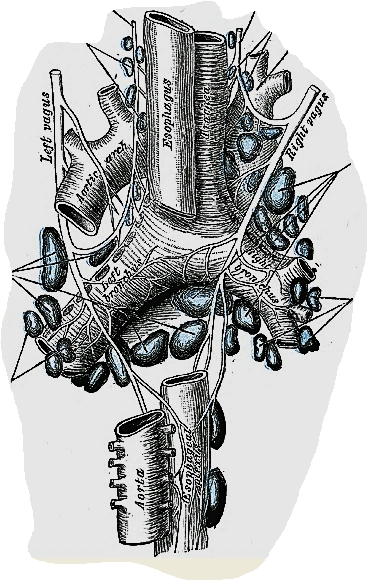
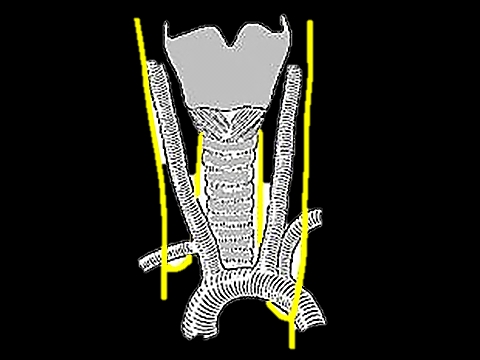
Knowledge of the anatomical relationships of the RLN to the tracheoesophageal groove, ligament of Berry, and ITA is essential. The course of the RLN with respect to the ITA is quite variable. Most commonly it crosses behind the branches of the artery, more predictably so on the left. However, the nerve may pass deep to, superficial to, or between the terminal branches of the ITA. Up to twenty anatomical variations have been described. In Figure 11 the RLN is seen to pass anterior to the artery.
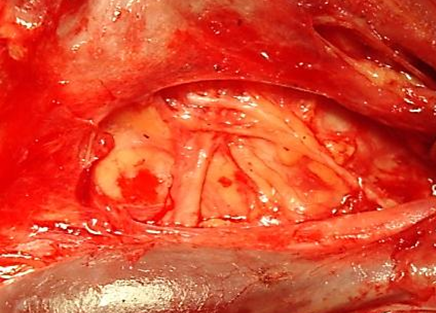
The majority of RLNs are located within 3mm of Berry’s ligament; rarely the nerve is embedded in it, and more commonly lies lateral to it.
Classically, the RLN is identified intraoperatively in Simon’s triangle, which is formed by the common carotid artery laterally, the oesophagus medially and the ITA superiorly (Figure 12).
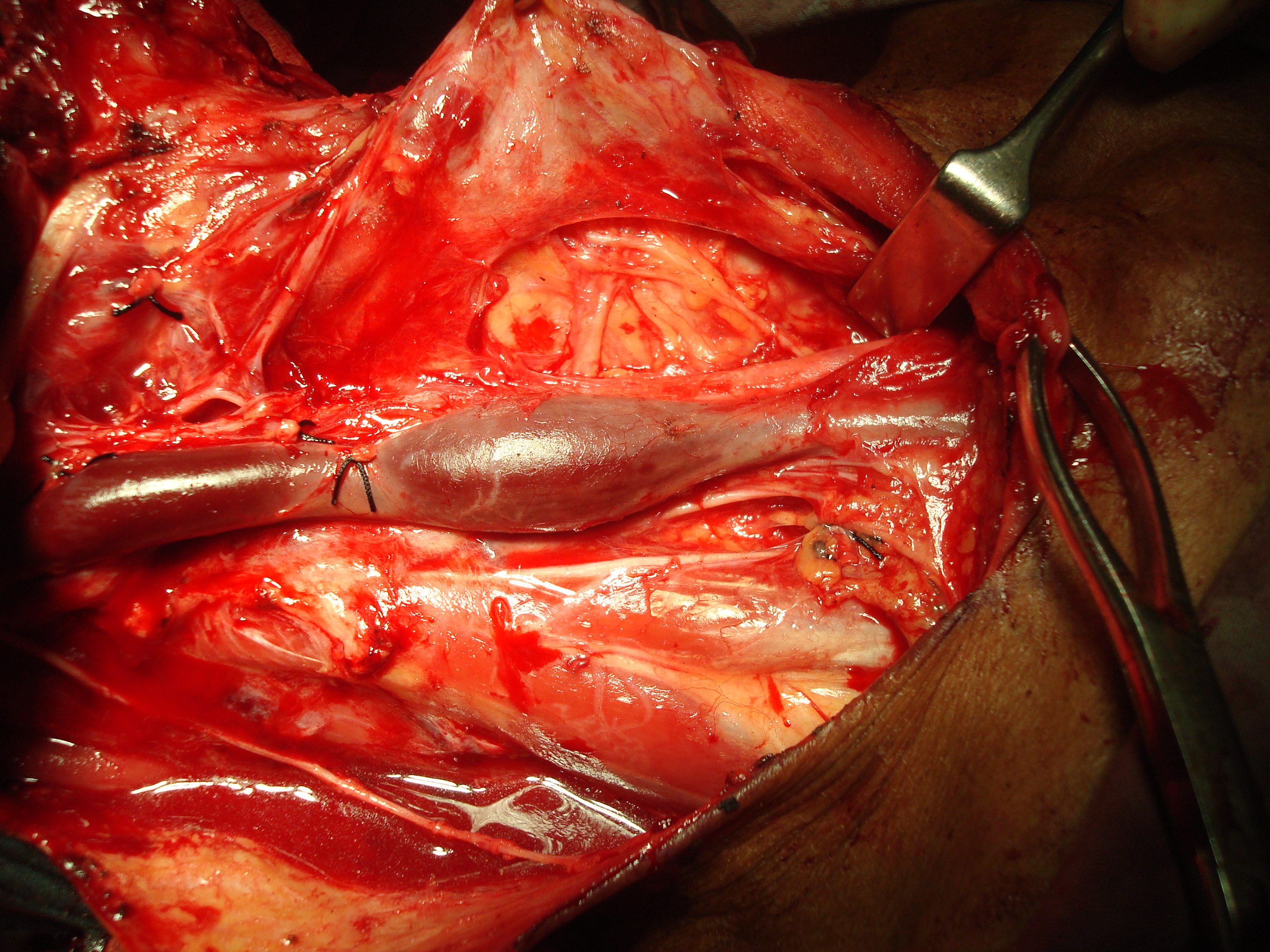
The Tubercle of Zukerkandl may also be used as an anatomical landmark to identify the nerve (Figure 4). The RLN generally courses between this structure and the trachea. However, this relationship can vary with enlargement of the tuberculum thereby placing the nerve at risk during surgical exploration.
The SLN is a branch of the Xn and has both an external and internal branch (Figures 13, 14). The internal branch is situated above and outside the normal field of dissection; it is sensory and enters the larynx through the thyrohyoid membrane.
The external branch innervates the cricothyroid muscle, a tensor of the vocal cord. Injury to the SLN causes hoarseness, decreased pitch and/or volume, and voice fatigue. These voice changes are more subtle than those relating to RLN injury are frequently underestimated and not reported. The external branch is at risk because of its close proximity to the STA (Figures 13, 14). Understanding its relationship to the upper pole of the thyroid and the STA is crucial to preserving its integrity.
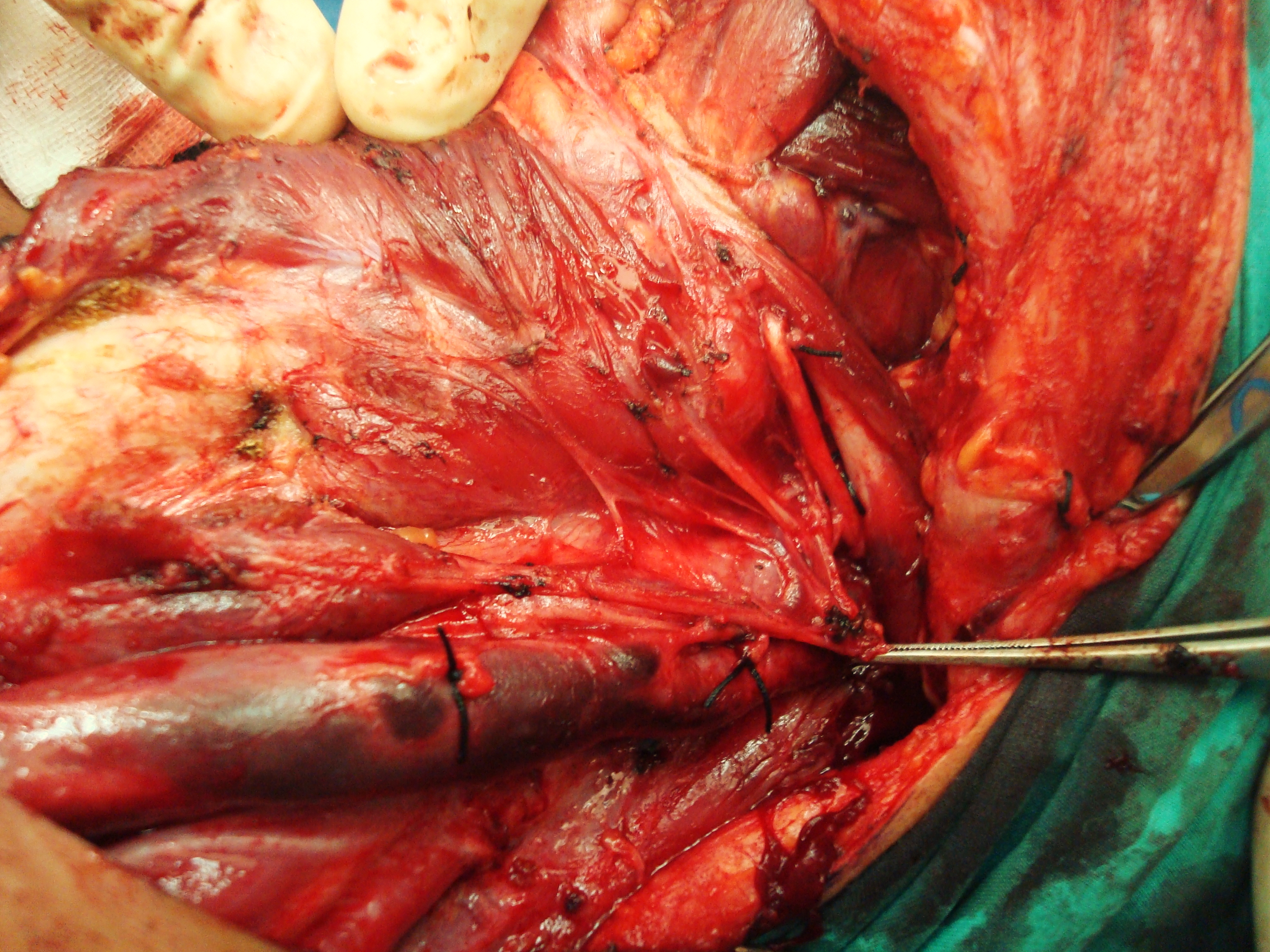
The usual configuration is that the nerve is located behind the STA, proximal to its entry into the superior pole of the thyroid. The relationship of the nerve to the superior pole and STA is however extremely variable. Variations include the nerve passing between the branches of the STA as it enters the superior pole of the thyroid gland; in such cases it is particularly vulnerable to injury.

Focused parathyroidectomy: This is the usual procedure for a well-localised solitary adenoma. The offending gland is removed through a limited incision with direct exposure of the previously imaged parathyroid adenoma.
Bilateral neck exploration: In cases of unsuccessful preoperative localisation the surgeon explores the necks fully, identifies all four parathyroid glands and removes the adenoma.
Subtotal parathyroidectomy: This is indicated with parathyroid hyperplasia when all the glands have the capacity for increased parathyroid hormone (PTH) production. This occurs in secondary and tertiary hyperparathyroidism and in the unusual situation of primary hyperparathyroidism due to multiple gland hyperplasia. The three largest glands are removed and a small remnant of the most normal-looking gland is either left in situ or transplanted to an ectopic site, typically the forearm.
Total parathyroidectomy: All parathyroid tissue is removed. This may be done as a salvage procedure in cases of recurrent secondary hyperparathyroidism.
Endocrine diagnosis: The diagnosis of primary hyperparathyroidism hinges on identifying an inappropriately raised PTH assay in the presence of elevated serum calcium. It is not unusual for hypercalcaemia symptoms of primary hyperparathyroidism to be non-specific and vague; hence it is often underestimated. Typical presentations include recurrent renal calculi, progressive bone density loss, pathological fractures, ill-defined musculoskeletal complaints, neurocognitive impairment, and unexplained abdominal pain; or it may present as a hypercalcaemic crisis. While the diagnosis of primary hyperparathyroidism is not difficult to make for surgeons well versed in endocrine disorders, the occasional parathyroid surgeon is well advised to consult an endocrinologist prior to proceeding with surgery.
SestaMIBI scan: This is a nuclear medicine imaging technique with the highest sensitivity and specificity for identification of primary hyperparathyroid adenomas and is the author’s investigation of choice. The use of Technetium99m (Tc99m) sestamibi for parathyroid imaging has led to a steady refinement of imaging. The accuracy is determined by the scanning technique employed; the dual-isotope (I123/ Tc99m sestamibi) scan provides better accuracy than the simpler sestamibi washout method. The pathological parathyroid can be localised pre-operatively with great confidence allowing for a quicker and more focused neck exploration. Recent data would suggest that the combination CT-99mTc-sestamibi-SPECT (reported sensitivity and specificity of up to 88% and 99% respectively) is the best approach for preoperative localisation with single gland disease. Unfortunately, these favourable results do not apply to all patients with parathyroid disease. It is important to note that failed localisation does not exclude primary hyperparathyroidism and is not a contraindication for surgical exploration.
Ultrasonography (US): The thyroid and surrounding structures can be evaluated with US. It has gained popularity due to the ease of the technique; many endocrine surgeons have the expertise to evaluate the neck in their own offices. Resolution has improved with newer generation equipment. The weaknesses of US are similar to 99mTc-sestamibi i.e. deep superior glands, ectopic glands and too-small glands are difficult to localise, and the mediastinum is inaccessible.
CT and MRI: CT and MRI are not indicated as first-line investigations, but may be useful to evaluate parathyroid adenomas with non-localising imaging studies or previously operated necks.
This diagnosis requires identification of an inappropriately raised PTH assay in the presence of an abnormally elevated serum phosphate-to-calcium ratio. The serum calcium typically falls within the normal range. Secondary hyperparathyroidism is almost always diagnosed in patients with chronic renal failure. Rarer causes include osteomalacia, rickets, and malabsorption. Secondary hyperparathyroidism contributes significantly to renal osteodystrophy and is associated with accelerated atherosclerosis, ectopic soft tissue calcification and skin ulcers in calciphylaxis. It contributes to a general feeling of malaise and musculoskeletal pain seen in chronic renal failure, and chronic pruritus. Close collaboration with a renal physician is essential to determine the best time for surgical intervention.
Scar: The incision is typically well-hidden within a natural skin crease of the neck, but tends to descend with ageing.
Airway obstruction/wound haematoma: <1% of parathyroidectomy patients are stridulous postoperatively due to a haematoma, oedema of the airway or injury to the RLNs.
Voice change: It is essential that the patient has a clear understanding of the risks relating to voice quality prior to surgery. While less common than with thyroidectomy, permanent RLN dysfunc-tion does occur. The risk is highest with repeat surgery or with parathyroid carcinoma.
Hypocalcaemia: Transient hypocalcaemia occurs in approximately 20% of patients following successful removal of adenomas. Paradoxically the higher the levels of calcium and PTH preoperatively, the greater the postoperative drop in calcium. Most patients can be managed on oral calcium supplements until the remaining parathyroid glands re-equilibrate. Hypocalcaemia occurs in all cases of secondary hyperparathyroidism and requires proactive management with large doses of oral calcium supplements and Vitamin D1-α. Persistent symptoms require intravenous calcium supplementation.
Failed exploration: Some cases of hyperparathyroidism cannot be corrected surgically due to unusual pathology or failure to remove the pathological ectopic parathyroids; the risk of failed exploration is approximately 5%.
Because identification of parathyroid glands is reliant on subtle shades of colour and consistency, the recognition of parathyroid tissue can be impossible in a bloodied surgical field; meticulous haemostasis is therefore critical. Whilst parathyroidectomy is often simple and quick, it is not a procedure that can be rushed and should be booked early on an operating list to avoid undue pressure in terms of available operating time. The surgeon has to be calm, unrushed and have a good assistant.
Skin incision: A curvilinear incision is placed in a skin crease approximately two finger breadths above the sternal notch between the medial borders of the sternocleidomastoid muscles (Figure 15). It is seldom necessary to make the incision longer than 4-5cm. Well-localized glands can be resected via a smaller incision. Placing the incision too low causes an unsightly low scar over the heads of the clavicles when the extended neck is returned to its normal position.
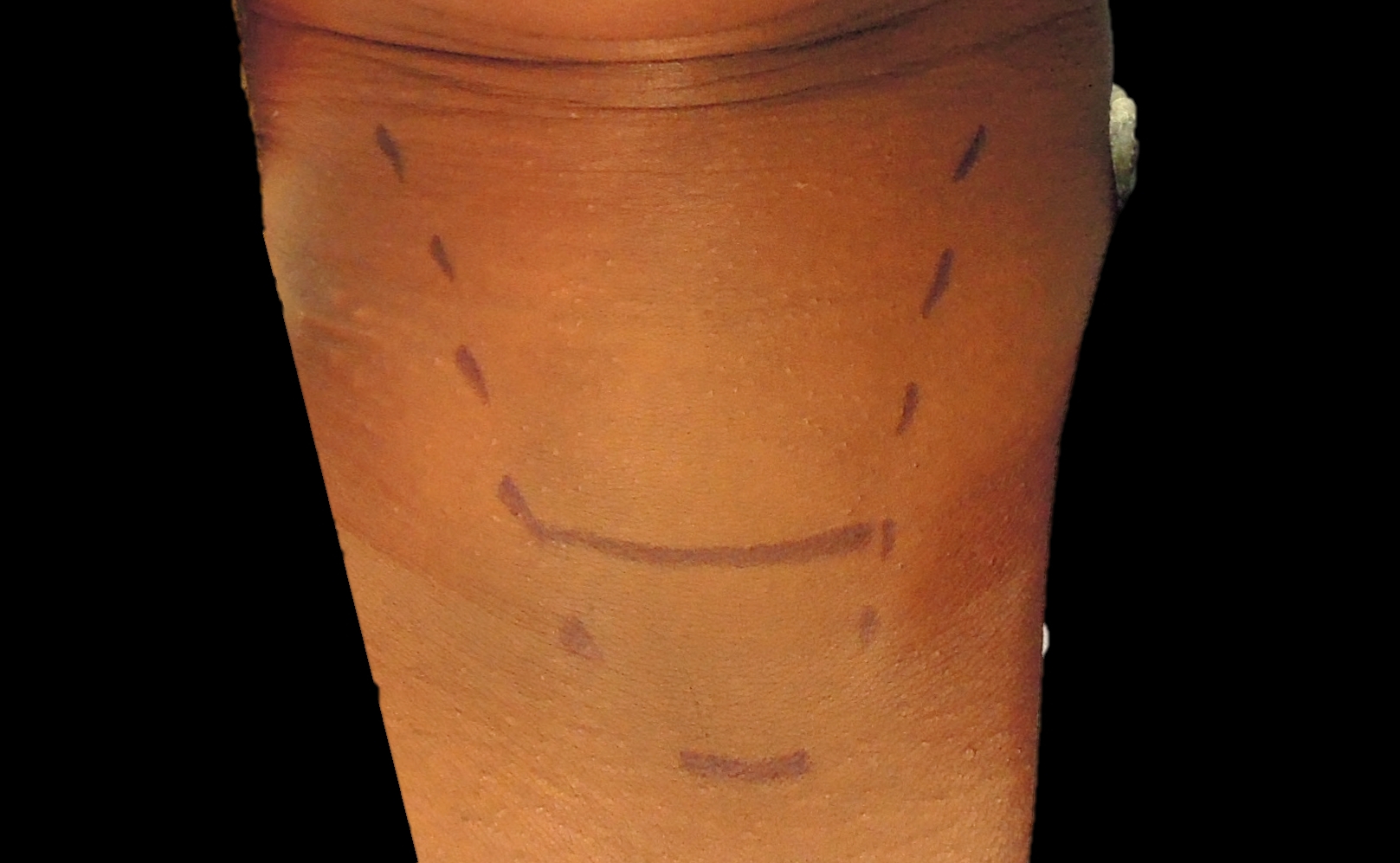
Subplatysmal flaps: Subcutaneous fat and platysma are divided, and a subplatysmal dissection plane is developed superiorly (platysma is often absent in the midline) remaining superficial to the anterior jugular veins, up to the level of the thyroid cartilage above, and the sternal notch below (Figure 16).
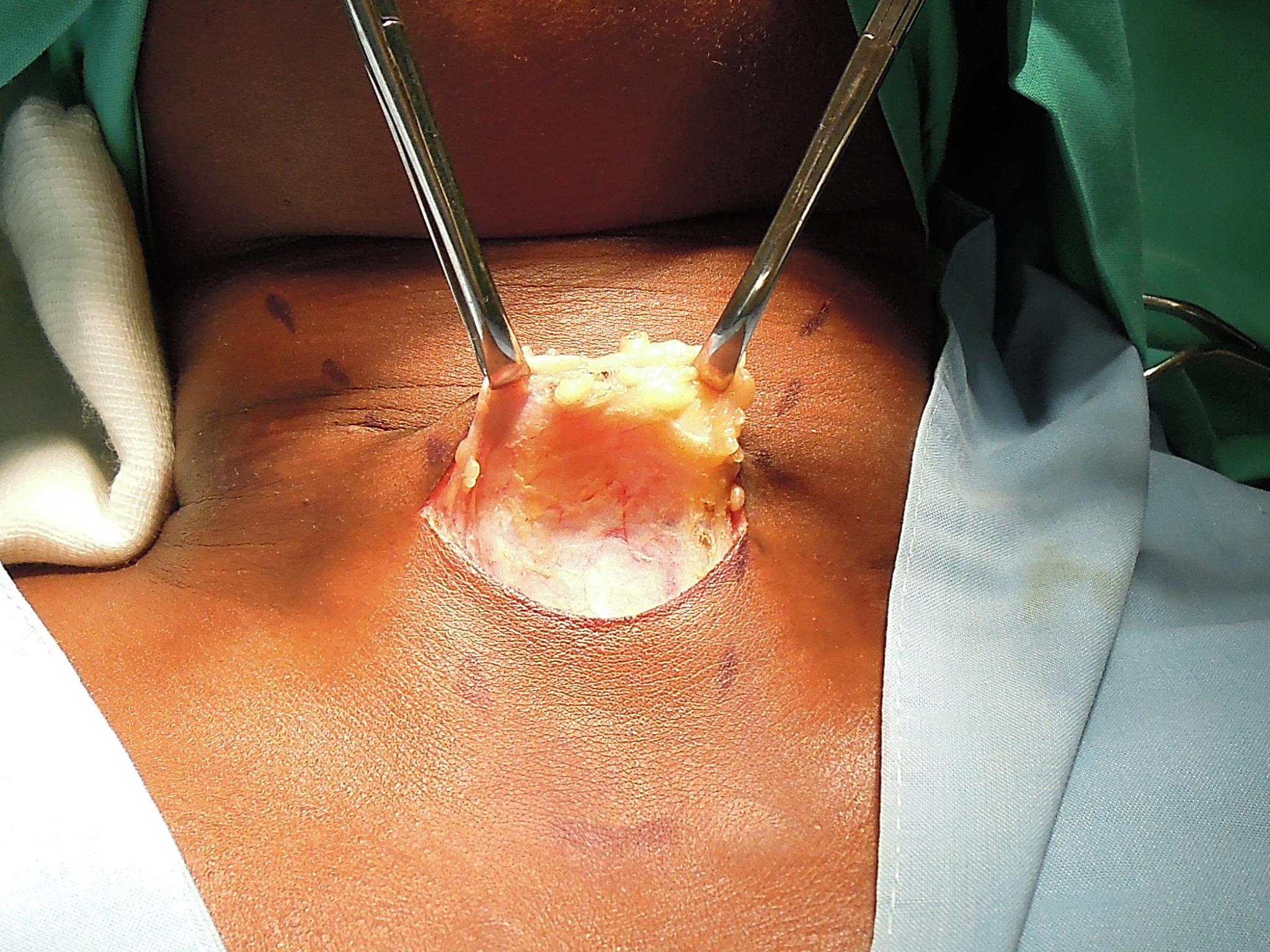
The skin flaps are secured with a fixed retractor (Figure 17).

Separating strap muscles and exposing the anterior surface of thyroid: The fascia between the sternohyoid and sternothyroid muscles is divided in the midline with diathermy or scissors (Figure 18). This is an avascular plane, though care must be taken not to injure small veins occasionally crossing between the anterior jugular veins, particularly inferiorly. The infrahyoid (sternohyoid, sternothyroid and omohyoid) strap muscles are retracted laterally with a right-angled retractor. In difficult cases the strap muscles may be divided to improve access.
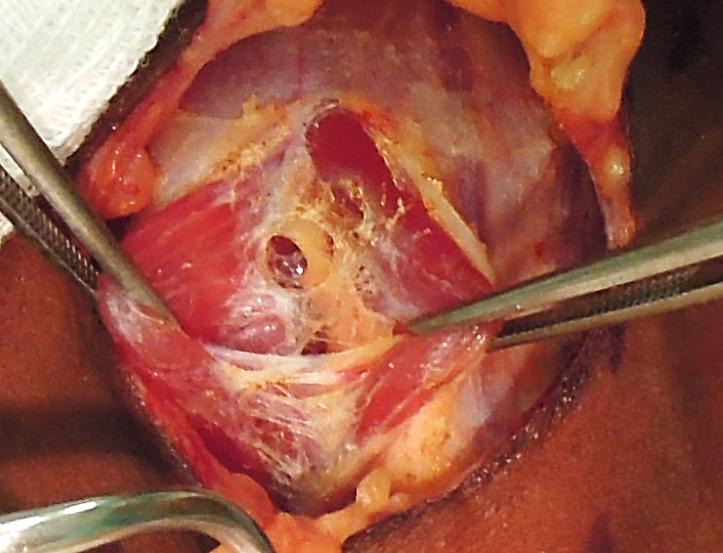
It is usual at this stage for the surgeon to move to the side of the table opposite to the parathyroid to be resected.
Delivery of thyroid towards midline: The infrahyoid (sternohyoid, sternothyroid and omohyoid) strap muscles are retracted laterally with a right-angled retractor. The thyroid gland is delivered medially by applying gentle digital traction to the gland (Figure 19).
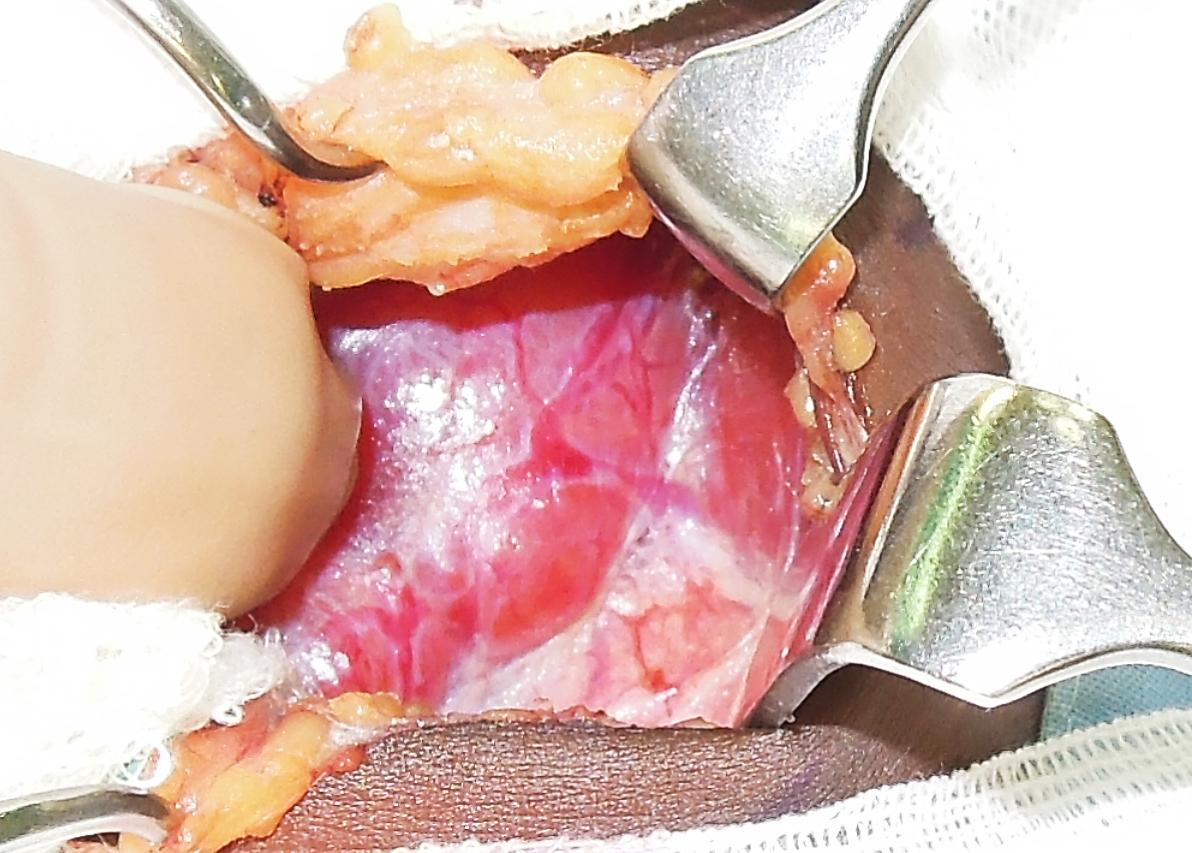
Division of middle thyroid vein(s): The vein is the first key vascular structure to be encountered and is tightly stretched by medial traction on the gland (Figure 19). Dividing the vein facilitates additional mobilisation of the gland and permits delivery of the bulk of the thyroid lobe into the wound (Figure 20). Although dividing it is not always essential, it is better to do so than to risk tearing it.

If the surgeon is confident about preoperative localisation then dissection is next directed at the parathyroid adenoma.
Identifying superior parathyroid: Full mobilisation and anterior delivery of the upper pole of the thyroid brings the region of the superior parathyroid gland into direct view. The superior parathyroid gland is normally located in a posterior position at the level of the upper two-thirds of the thyroid, and is closely related to the Tubercle of Zuckerkandl; it is about 1cm above the crossing point of the RLN and ITA. If the RLN’s course is viewed in a coronal plane, then the superior parathyroid gland lies deep (dorsal) to the plane of the nerve (Figures 4, 6, 7). It has a characteristic rich orange/yellow colour (Figures 21, 22). The (occasional) parathyroid surgeon may find the parathyroids difficult to identify especially if there has been bleeding in the surgical field, so care must be taken to ensure meticulous haemostasis.
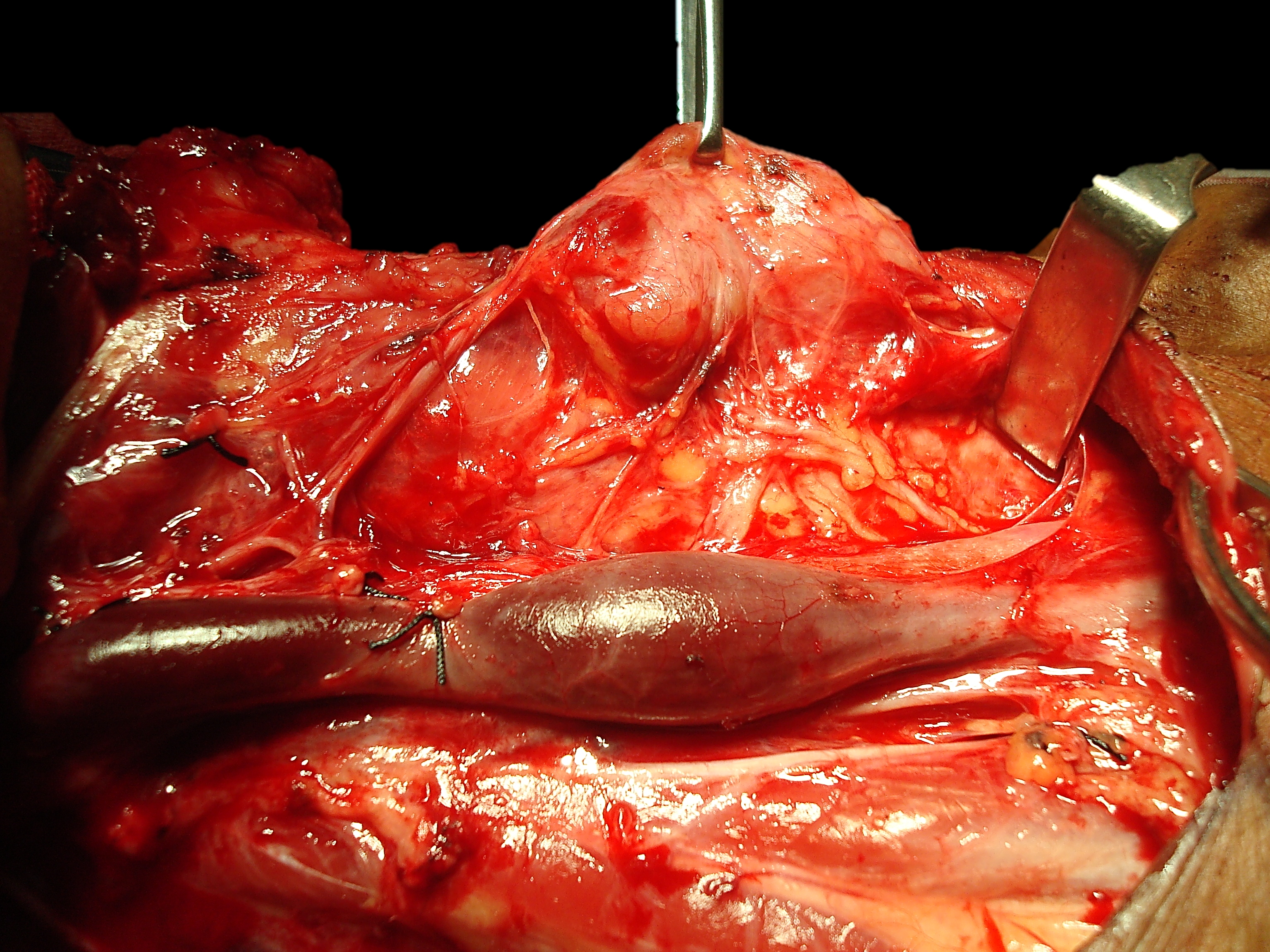
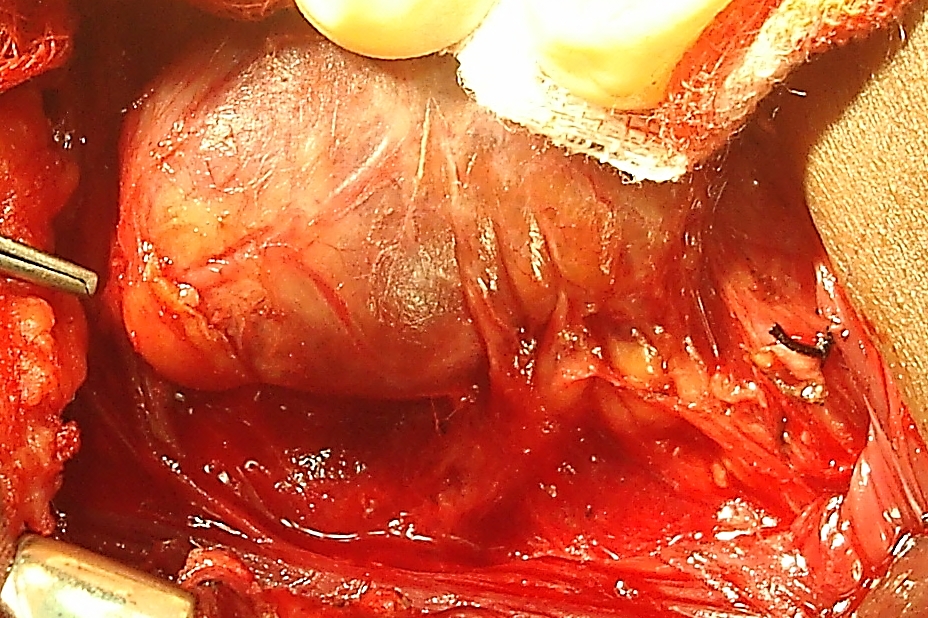
Superior and inferior parathyroids (PT)
The gland must remain in situ with blood supply intact. This is best achieved by carefully dissecting it off the posterior aspect of the thyroid gland, and using short bursts of bipolar cautery to control bleeding. If the gland still cannot be identified, it is prudent to divide the STA and completely mobilise the upper pole of the thyroid. This will almost certainly bring the superior parathyroid into view.
Identification of inferior parathyroid: The inferior gland is initially looked for at the inferior aspect of the lower pole of the thyroid or within the thyrothymic ligament. If the RLN’s course is viewed in a coronal plane then the inferior parathyroid is superficial (ventral) to the plane of the nerve (Figures 6, 7, 21, 22). Its location is more varied than with the superior gland, but if it is at its expected location then it is generally simpler to identify. The inferior parathyroids are most commonly located between the lower pole of the thyroid and thyroid isthmus, most commonly on the anterior or posterolateral surfaces of the lower pole of the thyroid (42%, Wang et al), or may be located in the lower neck in proximity to the thymus (39%). Preserving it in situ avoids damaging the ITA blood supply.
Removal of adenoma: (Figures 23, 24) Once the abnormal parathyroid has been identified, it is removed. Parathyroid tissue can autotransplant if fragmented, so great care is taken to deliver an intact gland by delicately grasping its capsule until the vascular pedicle is identified. This is then be ligated with a 3/0 tie.
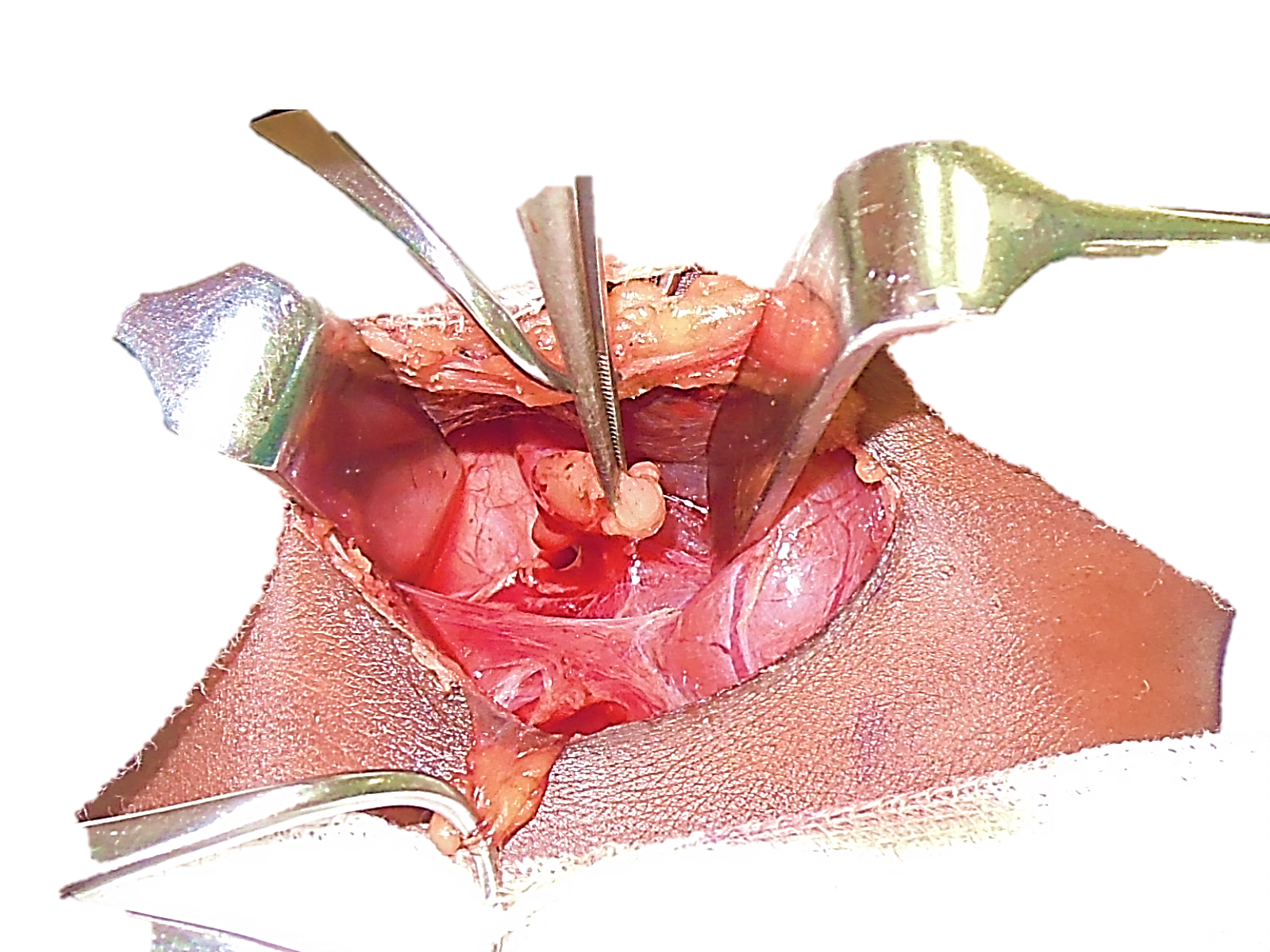
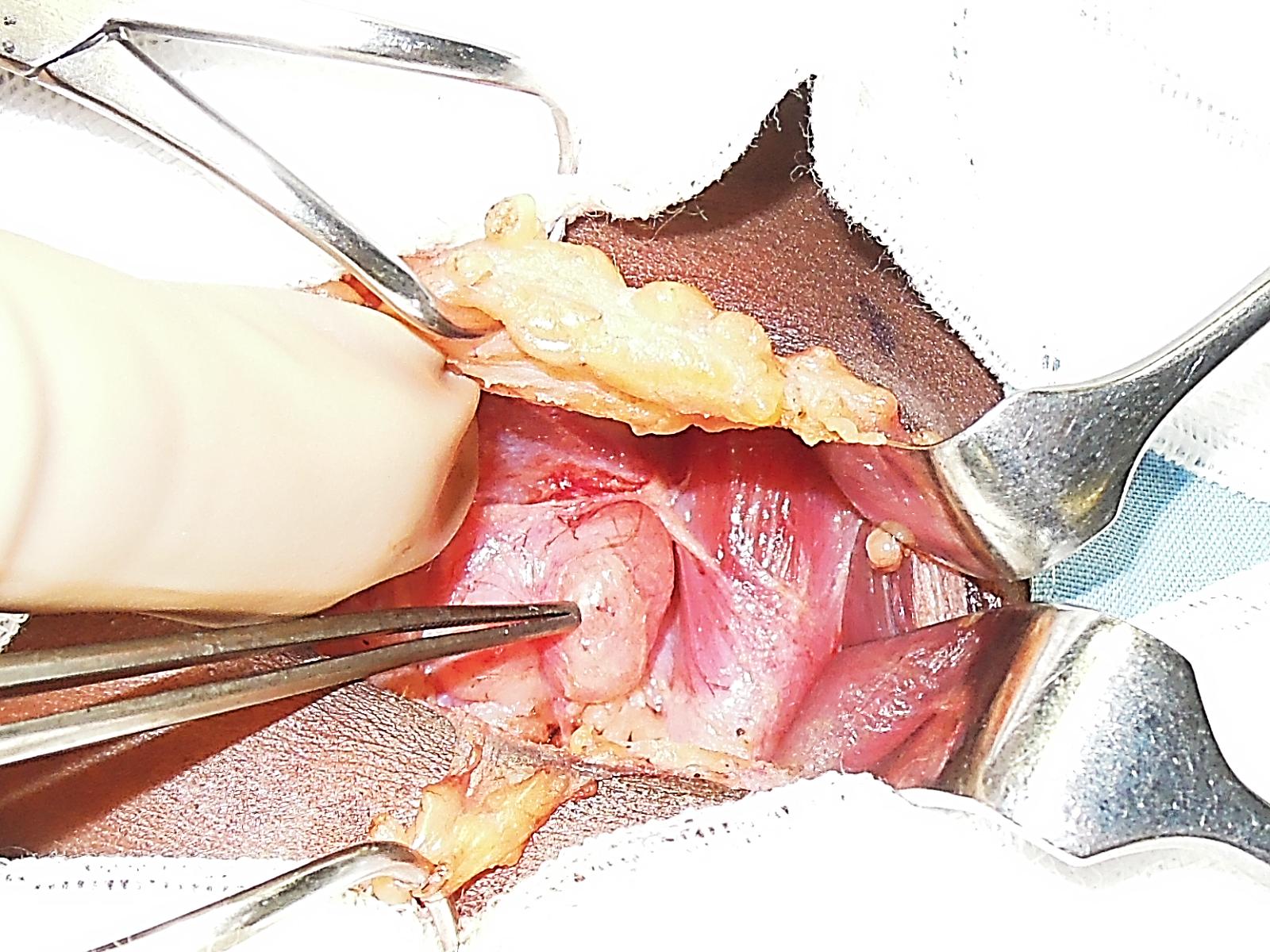
Confirming successful removal: After identifying the parathyroid glands, it is essential to distinguish between normal and pathological glands. Simple rules of thumb are that increased size correlates with pathology, and that marked elevations of calcium and PTH levels are usually caused by larger adenomas. Adenomas are typically more rounded than normal parathyroid glands and have a darker, fleshy parenchymal appearance, sometimes described as similar to a “rat’s heart”. They are typically 1-2cm in diameter and are significantly heavier than normal glands (Figure 25). Occasionally small adenomas (<1cm) and very large ones (up to 8cm) are found (Figure 1).
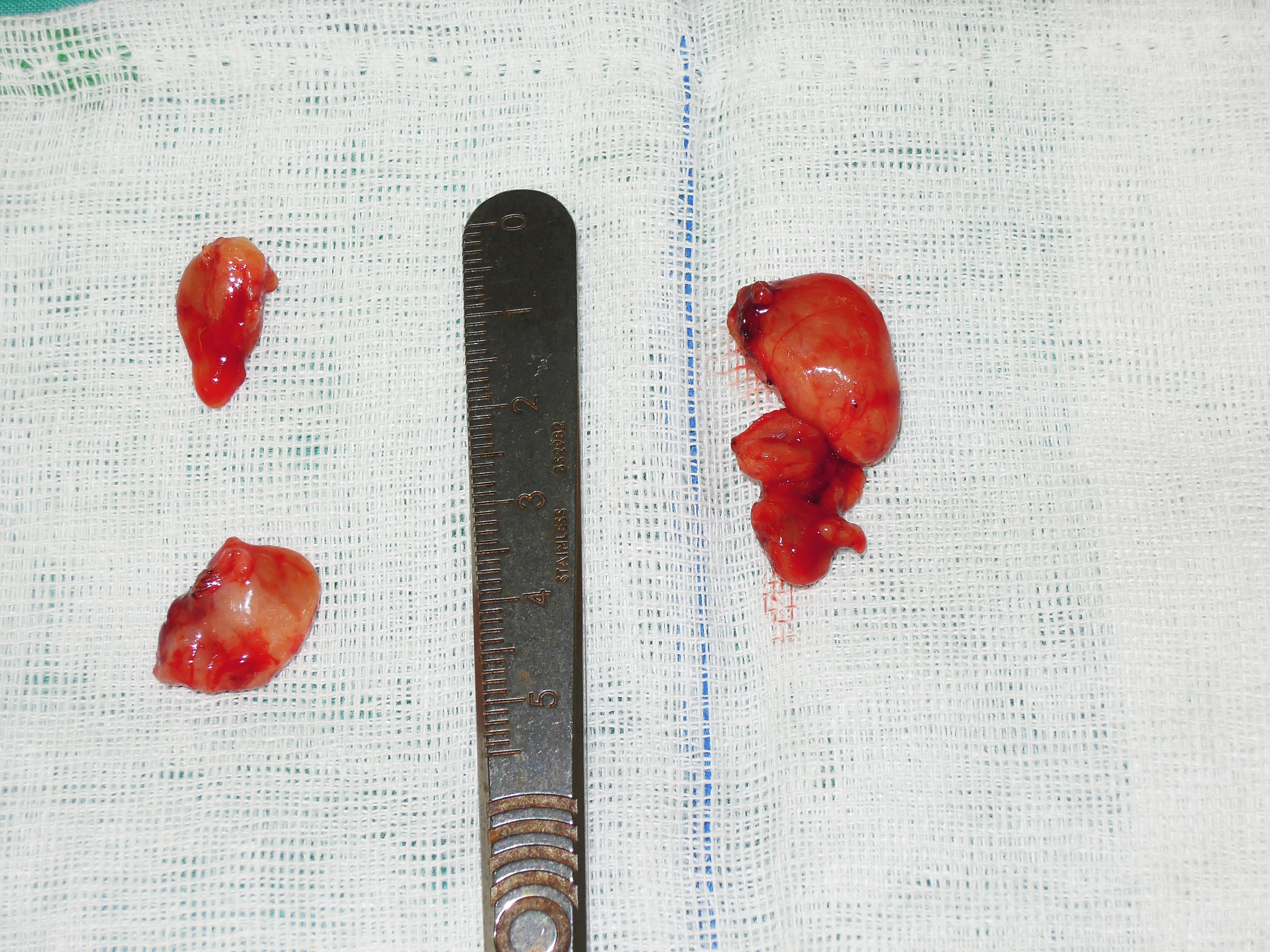
The occasional parathyroid surgeon is well advised to confirm that abnormal parathyroid tissue has been removed as it is easy to mistake fat, lymph gland, thymus, a superficial thyroid nodule, or normal parathyroid for an adenoma, particularly if the dissection has been difficult. This can be done in two ways:
The missing gland: The majority of parathyroid operations are simple, quick and rewarding for both surgeon and patient. However on occasion parathyroid glands may be infuriatingly difficult to identify and tests the skill and patience of even the most experienced endocrine surgeon. Surgery is likely to be more complex in the following situations and the occasional parathyroid surgeon should consider referring such cases to an expert:
If exploration fails to reveal convincing evidence of a parathyroid adenoma then two likely scenarios apply:
A missing superior parathyroid gland is almost always located where it is meant to be i.e. in its normal position at the level of the upper two-thirds of the thyroid, in a posterior position, about 1 cm above the point where the RLN crosses the ITA. The surgeon needs to further mobilise the upper pole of the thyroid anteriorly. The parathyroid may be covered by a fine layer of thyroid capsule; dissecting onto the thyroid parenchyma itself may release it and bring it into view. Should it still not be visible one then needs to transect the STA to fully mobilize the upper pole. If it still cannot be located then one may be dealing with the rare situation of ectopic retrooesophageal and retropharyngeal locations and these regions need to be explored.
A missing inferior parathyroid gland poses more of a challenge as the anatomical variations are greatest. The following areas need to be systematically explored:
If this still fails to identify pathological glands it is then reasonable to abandon the procedure and to consider secondary exploration after more exhaustive imaging 6-12 months later.
Wound closure
Postoperative care
Specific Scenarios
Secondary hyperparathyroidism: Up to 90% of patients meeting criteria for haemodialysis have secondary hyperparathyroidism. Surgery is indicated for:
Three different surgical procedures involving bilateral neck exploration are employed for patients with secondary hyperparathyroidism who fulfil criteria for surgery. Each operation has its proponents and an institutional history. There is no convincing evidence of superiority of any one approach:
Repeat surgery for failed exploration: Such cases should be managed by surgeons well versed in the subtleties of parathyroid surgery. The following issues need to be carefully considered before embarking on expensive investigations and repeat surgery:
If a convincing case can be made for re-exploration, then the most helpful imaging remains Tc99m-sestamibi and cervical US. If both are negative then a CT-scan may add useful information. Whilst potential ectopic locations of parathyroids should be considered, the majority of missed parathyroid glands are located within the cervical region. Repeat neck exploration for persistent or recurrent disease can be very difficult as the normal tissue planes are scarred and it is associated with higher rates of injury to the RLN and permanent hypoparathyroidism. The lateral or ‘‘back-door’’ approach (dissection between the anterior border of the sternocleidomastoid muscle and posterior border of the strap muscles) may be useful as it provides direct access to the posterior surface of the thyroid gland without encountering scar tissue from previous surgery done through the conventional anterior approach.
Radioguided parathyroidectomy: This technique may be helpful with complex repeat surgery, but the author does not use it for routine parathyroidectomy due to cost and logistic constraints. It is similar to other radioguided techniques such as sentinel lymph node biopsy. A para-thyroid-specific radiotracer such as Tc99m-sestamibi is administered intravenously approximately 2hrs prior to surgery; this time delay allows for a high concentration of isotope to be retained within the parathyroid adenoma whilst it has started to wash out from other sites of uptake such the salivary glands and thyroid. A gamma camera is used intra-operatively to identify the adenoma.
Minimally invasive parathyroid surgery: A number of techniques have been devised to reduce the length of the skin incision and to bring the putative benefits of minimally invasive techniques to thyroid and parathyroid surgery. Minimally invasive parathyroidectomy can be performed via a limited 2-3cm cervical incision with visual assistance of an endoscope, but since it can be performed with a similarly sized incision with direct visualisation, this technique is not widely used.
Eugenio Panieri MBChB, FCS
Associate Professor
Division of General Surgery
University of Cape Town
Cape Town
South Africa
eugenio.panieri@uct.ac.za
Johan Fagan MBChB, FCORL, MMed
Professor and Chairman
Division of Otolaryngology
University of Cape Town
Cape Town
johannes.fagan@uct.ac.za